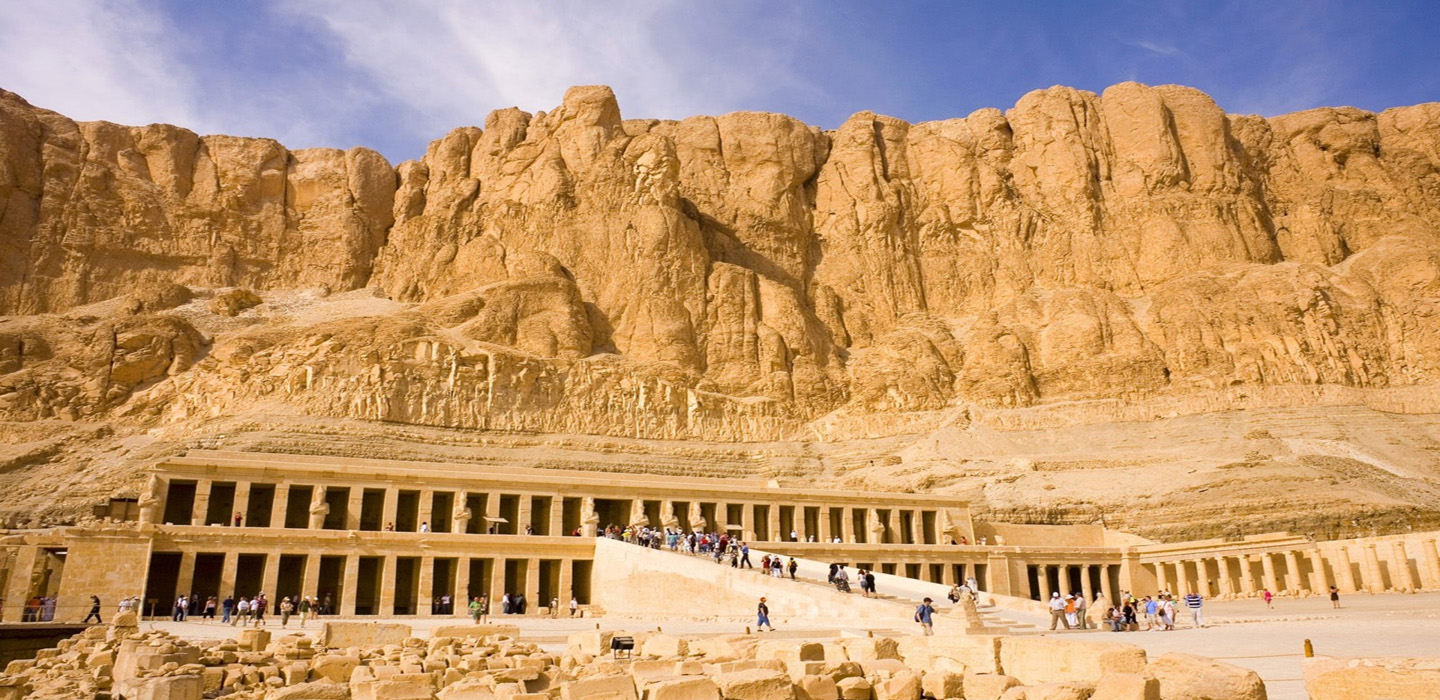Rising majestically against the rocky cliffs of Luxor’s West Bank, Hatshepsut Temple is one of Egypt’s most iconic architectural marvels. Dedicated to one of Egypt’s most successful female pharaohs, Queen Hatshepsut, this ancient temple is a testament to her power, ingenuity, and divine right to rule. Visiting this stunning site offers a unique opportunity to learn about a woman who defied expectations and left a lasting legacy in Egypt’s history.

Historical Background
Hatshepsut, who ruled as pharaoh during the 18th Dynasty, was one of the few women in Egypt’s history to hold the title of king. Her reign was marked by peace, prosperity, and ambitious construction projects, and her mortuary temple, known as Djeser-Djeseru (meaning “Holy of Holies”), stands as a symbol of her strength and vision.
The temple was designed by Hatshepsut’s trusted architect, Senenmut, and it is considered one of the best-preserved and most architecturally significant sites from ancient Egypt. It was built into the cliffs of Deir el-Bahari, and its structure blends harmoniously with the natural landscape. The temple's construction spanned over 15 years, and it was intended to honor the gods, including Amun, and to commemorate Hatshepsut's divine birth and ascension to the throne.
Cultural Significance
Hatshepsut's temple is more than just an architectural feat—it's a symbol of the pharaoh’s divine legitimacy. The temple’s design reflects the religious and political landscape of Egypt at the time. The terraced structure of the temple is thought to represent the sacred mountain where the gods resided, symbolizing Hatshepsut’s connection to the divine.
The walls of the temple tell the story of Hatshepsut’s reign through detailed reliefs, including her famous trading expedition to Punt, where she brought back rare and valuable goods for Egypt. These images not only glorify Hatshepsut's reign but also assert her power and influence, despite her gender.
Additionally, Hatshepsut’s legacy is marked by the remarkable success of her reign, which included flourishing trade routes, military expeditions, and a strong economic base.
Visitor Information
Location & Access:
Hatshepsut Temple is located on the West Bank of Luxor, near the Valley of the Kings. It’s easily accessible by car or as part of a guided tour.
Ticket Information:
Entrance to the temple requires a general ticket to the West Bank archaeological sites. For those visiting other nearby sites, such as the Valley of the Kings, multi-site passes are available.
Opening Hours:
Best Time to Visit:
Unique Experiences
-
Reliefs and Scenes: One of the most striking features of Hatshepsut Temple is its beautiful and well-preserved reliefs. The walls of the temple depict Hatshepsut’s divine birth, her coronation, and the famous expedition to Punt. These vivid images offer visitors a fascinating glimpse into ancient Egyptian history.
-
The Terraces: The temple’s grand terraces provide stunning views of the surrounding desert landscape and the Valley of the Kings. Climbing the steps to the top terrace will give you a fantastic vantage point to see the beauty of the temple’s layout and the surrounding area.
-
The Hidden Chambers: The temple also houses hidden chambers, including an underground area that was likely used for sacred rituals. These areas are off-limits to most tourists but are an interesting part of the temple's history.
-
The Sacred Lake: The temple complex features a large sacred lake, which was used for ceremonial purposes. Though no longer filled with water, the lake’s ruins still reflect the grandeur of the temple’s original design.
Conclusion
Visiting Hatshepsut Temple offers a unique opportunity to step back in time and witness the architectural brilliance and historical significance of one of Egypt’s greatest female rulers. This awe-inspiring temple stands as a testament to Hatshepsut’s leadership, vision, and enduring legacy. Whether you’re fascinated by Egyptian history or simply captivated by the beauty of ancient architecture, Hatshepsut Temple is a must-visit destination.
Ready to explore the wonders of Luxor and uncover the secrets of Egypt’s ancient rulers? Book your tour with Luxor Booking Tours and step into the world of pharaohs, gods, and timeless monuments.
Quick Facts Box
- Location: West Bank, Luxor, Egypt
- Opening Hours: 6:00 AM – 5:00 PM
- Top Highlights: Reliefs depicting the Punt expedition, the grand terraces, the sacred lake
Links and further reading
Author’s Note:
"As a local guide with years of experience in Luxor, I believe every visit to the Hatshepsut Temple reveals something new. Let Luxor Booking Tours guide you through this incredible journey—an experience you’ll never forget!"